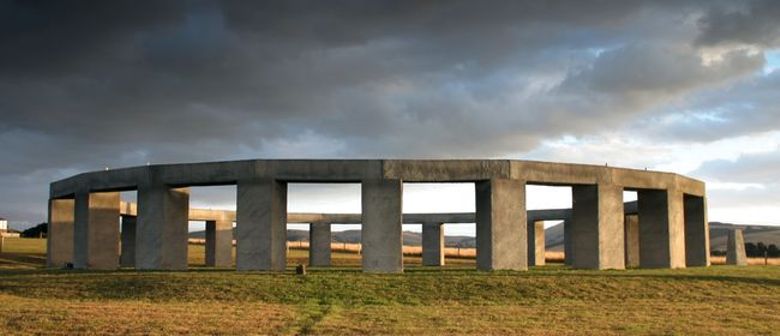While researching new material for a blog, I was surprised to discover we have our own Stonehenge in New Zealand.
Astronomy is the oldest of all sciences and is the cornerstone to the rise of civilization. It gave mankind an understanding of time and the seasons which lead to knowledge allowing for correct planting and harvesting.
 Stonehenge Aotearoa (eventfinda.co.nz)
Stonehenge Aotearoa (eventfinda.co.nz)
Just like the famous 4000 year old Stonehenge on the Salisbury Plains in England, New Zealand’s Stonehenge, or Stonehenge Aotearoa as it’s called, is a huge astronomical clock constructed from circles of stone. However, the local version is not just a replica of the famous English original. Both circles are 30 metres in diameter and have the same task but that is where the similarities between the English and New Zealand henges end.
ASTRONOMICAL CLOCK
The Kiwi Stonehenge has been constructed in the heart of rural Wairarapa on a flat parcel of land above river flats not too far from the Tararua Ranges around 8okm north of Wellington. It seems an odd place for such a prehistoric structure but its location on the other side of the world in a young country makes sense. It is designed for its specific location’s latitude and longitude to accurately track the seasons and help New Zealanders understand the science of our southern skies.
There are other astronomical clocks around the place but this one is unique because it links with Maori astronomy. This means it uses the navigational points of the Maori star-compass that Tahitian chief and navigator, Kupe and his fellow sailors used to navigate their way to and from New Zealand and around the Pacific long before James Cook charted the same islands.
BUILDING THE DREAM
One of New Zealand’s top astronomers, Richard Hall, came up with the idea to build a local Stonehenge. He had the assistance of the Phoenix Astronomical Society and its 250 members who laboured without pay for two years to construct it. Over a thousand hours was needed to complete the required surveying and astronomical calculations while the Royal Society of New Zealand helped in the funding.
Visitors to the site are shown a video explaining the history of stone circles and astronomical clocks and to explain the structure’s role to accurately track the seasons and help New Zealanders understand the star movement, complexity and scientific truths of the southern skies.
Every year, people who are interested in diverse aspects of astronomy come to the site for Stargate. They gaze through a variety of telescopes they bring with them and listen to interesting talks and take part in workshops.
Stonehenge Aotearoa (the Maori name for New Zealand) also has regular events at the solstices and equinoxes, the largest being June’s winter solstice on the shortest day of the year. The summer solstice on the longest day is a smaller event as are the two equinoxes at spring and autumn. The highlight of the equinox events is viewing the sun set over the appropriate heelstone. At all the Stenehenge events, just as in England, participants dance to celebrate the change of season. It is all about being as true as possible to the purpose of the original Stonehenge, and to presumably make the events held there fun. The site has also become increasingly popular for wedding photos and other festive events and no doubt, will attract more photographers as word spreads of its existence.
The few people I spoke to after writing this blog had not heard of Stonehenge Aotearoa. I guess it’s something Kiwis didn’t expect to find in New Zealand so it never came on their radar.
I found this review on Tripadvisor informative: ”The pre tour video and talk with the front person allowed us to better comprehend the workings of the henge and the way that the universe aligns. The other amazing thing was the sound resonance in the henge itself. Amazing that the acoustics are really quite something..the mere sound of a handclap or the raising of one’s voice creates an all round effect. And I was told it’s OK to bring your own musical instrument. I wonder what an acoustic guitar may sound like here. I hear tell that there is a Pink Floyd music event with Lasers held each year. Learning about the universe and the vast expanse of same in the sky, the way that plotting is done, the regularity of meteors and timings of astral activity, some amazing photography in the theatre, all were of interest and well conveyed by the lady in the booking office. This is a work in progress and has been a labour of love.”(edited)
Ceidrik Heward
Ceidrik Heward is an Amazon TOP SELLING AUTHOR and has lived and worked in 7 countries working as a TV cameraman, director and film tutor. For the past 17 years he has focused on writing and has been published in magazines and newspapers in Europe, USA, Asia and the Middle East.
His interests include photography, psychology and metaphysics. He loves to read and always has at least 3 books on the go. He has written 22 manuals/books and has just completed his 4th short novel. Ceidrik believes sharing information and stories is the best way to stimulate the imagination and enrich our lives.


















 Visit Today : 214
Visit Today : 214 Total Visit : 1133391
Total Visit : 1133391
Speak Your Mind